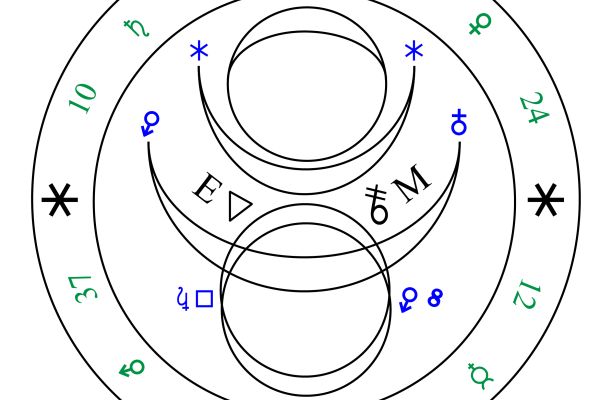
No left without a right. No up without a down. No inside without an outside. Opposites give each other meaning and are inextricably connected to each another. One of the great dualities or dichotomies is the one consisting of lightness and darkness. The creation and separation of light and dark comes up in the myths of creation or cosmogony—from kosmos, meaning “order,” and genesis, meaning “birth.” A cosmogony or cosmic creation story is also a metaphor for not just cosmic birth but individual birth and the birth of individual consciousness and identity.
For many Western readers the creation of the universe given to us from Christianity is well-known. We are told that “the earth was without form, and void; and darkness was upon the face of the deep.” Later, “God said, Let there be light: and there was light.” Ultimately, “God divided the light from the darkness.” So initially, in this telling, darkness and light are connected—if not one—and later divided. Hesiod’s Theogony says that “First of all, the Void came into being” and “out of Void came Darkness and black Night, and out of Night came Light and Day.” Even the Big Bang, which originated from our modern mythology of science, is described as an explosion of light. In various Chinese cosmogonic myths, light and dark have a prominent role as essential features and forces of the universe. Whereas light, active, male energy forms yin energy, yang energy is formed from dark, passive, female energy. The stereotypical gender assignments notwithstanding, the yin and yang concept expresses a very important theory of creation, personality, and psychology.
A common example is the yin and yang symbol, which you have probably seen before. You may be less familiar with the philosophical interpretations of the symbol. Rather than operating as two discrete, separate forces, yin and yang are complementary. Each contains the seed or possibility of the other. Another implication is that everything shares both qualities and nothing is purely yin or yang. Yin and yang may not be so much fixed properties as they are fluid possibilities and momentary manifestations. Indeed, it may be the perspective of the observer rather than any absolute, inherent quality of the observed that prescribes meaning. In short, it may be our imperfect, subjective, and limited perspective more than anything else that determines whether something is light or dark, good or evil, positive or negative, and so forth. And, if we enlarge our view, we will find that little if anything is completely one state or the other. If there are two sides, then they are two sides of the same coin.
One of the myths that best illustrates this principle is Eshu, an African orisha, or spirit manifestation of the Supreme Deity, from the Yoruba mythology. One of the stories of Eshu concerns two good friends who each work as farmers in their respective fields. Eshu comes walking along the line that divides their field and he wears a cap that is two different colors, one on each side; each color is, therefore, visible to only one of the men. Later, the two men get in a fight over what color cap Eshu was wearing. Eshu arrives and puts an end to the quarrel by showing both men his two-colored hat. Thus, each man is right, but not completely, and each man is wrong, but not completely. It’s a matter of different, but not incorrect, perspectives of the same event and person.
According to philosophers and psychologists, our perceptions are influenced by the interaction between our sensory-motor capabilities – in this case, what each man can see – and our environment or history with others. Incidentally, it’s easy to understand why Eshu is often found at a crossroads and that he is considered a trickster or prankster. How many times when we think we are arguing about difference are we really just debating different expressions of sameness?
The light/dark pairing also echoes the ways in which we make choices in our lives and judgments about other people. According to Kahneman and Tversky’s prospect theory, our decisions are impacted by the way choices are presented to us as well as our cognitive response to our potential losses. If, for example, a choice is presented in a way that highlights our potential losses, we will view that option more negatively; whereas, if the same option is presented to us in a way that emphasizes gains, we will view it more favorably. Our brain quickly dumps ideas into “good” or “bad” buckets. Unfortunately, we often make attributional biases when examining behavior. Specifically, Jones and Harris explain that we have a tendency to judge others more harshly and blame their behavior on their own internal characteristics; whereas we judge ourselves more lightly and blame our poor behavior on situational characteristics. To further complicate the problem, our brains are naturally wired to take short cuts and make quick assumptions, such as trying to determine if a person is a criminal. Our perceptions of good and bad will play a role in our decision. According to Freud, much of our behaviors and the decisions we make are influenced by the unconscious mind. Research on colors and symbols in psychology has revealed that dark is often associated with power, authority, and strength; whereas light is often connected to righteousness, goodness, and peace.
One of the best actualizations of this light/dark symbolization is the Star Wars saga. One can oversimplify it as a series of movies about a bunch of space wizards twirling light sticks around. But there is a whole lot more going on. One of the foundations of the series is that a light and a dark side exist as opposite, but related, manifestations of a larger power called the Force. A select group known as Jedi can tap into the Force and gain enhanced abilities. The light side is about defense, peace, and objective considered action. The dark side is about war, aggression, greed, and snap emotional reaction. Essentially, the light side is the good side and the dark side is the bad side. In reality, we may be quick to put people into “good” or “bad” buckets, where our behavior toward them is influenced by the stereotypes and behaviors we associate with such people. A few characters in Star Wars move from one side to the other or at least venture toward the perimeters, but for the most part, once they are on the path, it is the path they stay on. This type of character arc may reflect something of how we think about ourselves and others.
Perhaps we are not battling for the fate of the universe, overthrowing a destructive empire, or seeking to liberate all the known worlds, but that does not mean our struggles, our choices, our paths are insignificant. At the personal level the same fundamental questions are just as present as at the universal level. We need to continuously be honest with ourselves when asking fundamental questions. Are we working for something good or are we working for something bad? Are our perceptions of a person or their group influencing our behavior toward them? Are we happy or unhappy? Are we being cognitively lazy and not challenging our ideas of what is good and what is bad? Are we moving through this world with goodwill and a helpful intent or are we just looking out for ourselves and calculating through and choosing strategies that will bring us what we think we want at the expense of other people and beings? What are we trying to gain and why? Which path are we on?
















